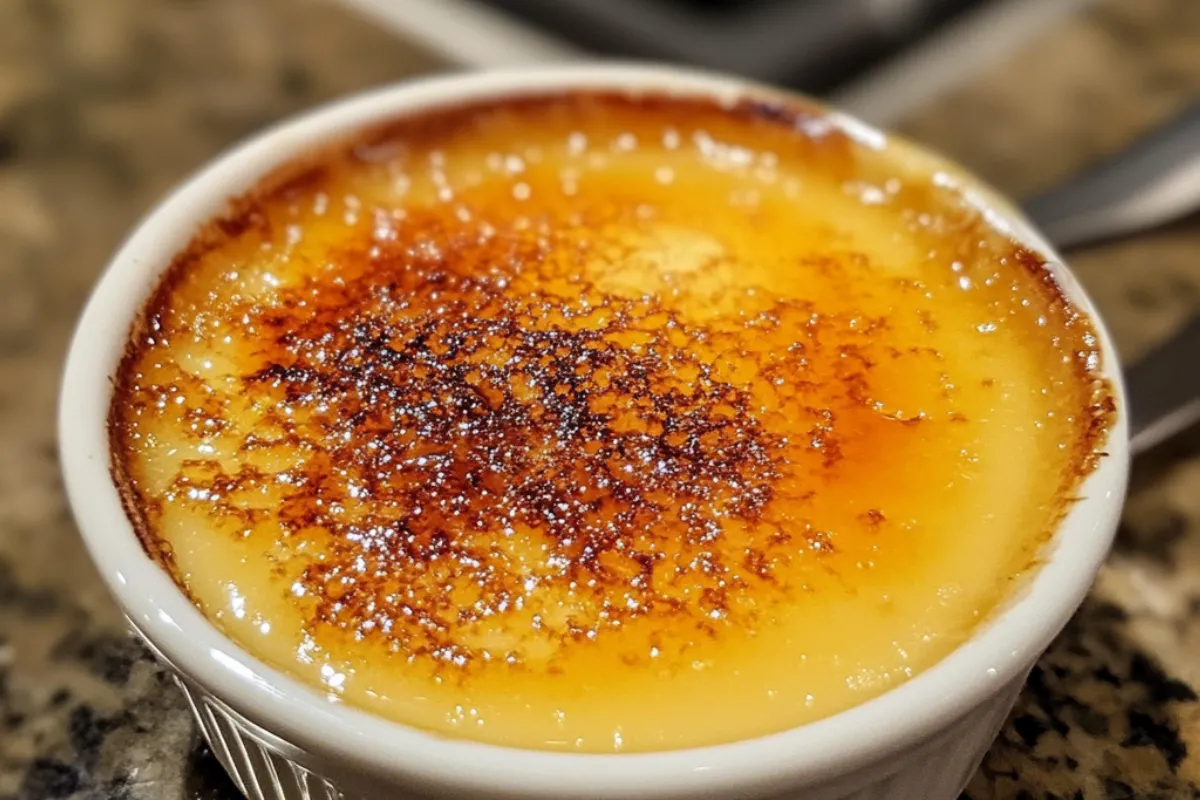If you love creamy, luscious desserts, you’ve likely enjoyed flan, crème brûlée, and panna cotta at some point. While these custard-based treats share similar textures, they differ significantly in terms of ingredients, preparation, and flavor. Understanding these differences can help you choose the right dessert for your next meal or special occasion.

In this article, we’ll explore the key differences between flan, crème brûlée, and panna cotta by covering their ingredients, cooking methods, and origins. Additionally, you’ll discover when to serve each dessert and how to make them at home.
For a twist on the traditional brûlée, check out this Crab Brûlée Recipe, offering a gourmet seafood version of this classic dessert.
Origins of Flan, Crème Brûlée, and Panna Cotta
Each of these desserts comes from a different culinary tradition. Understanding their origins adds context to their unique characteristics.
- Flan originated in ancient Rome and later became popular in Spanish and Latin American cuisine. Recipes for flan were passed down through generations, making it a beloved dessert worldwide.
- Crème Brûlée has roots in 17th-century France, where it is known for its distinctive crunchy caramelized sugar top. Over time, it became a symbol of fine dining and gourmet cuisine.
- Panna Cotta, which means “cooked cream” in Italian, comes from Italy. Unlike the other two desserts, panna cotta is simpler and uses gelatin instead of eggs to set its texture.
To learn more about the history of crème brûlée and its importance in French cuisine, check out the history of crème brûlée.
Basic Ingredients and Preparation Methods
At first glance, these desserts may seem similar; however, their ingredients and preparation methods vary greatly, resulting in distinct textures and flavors.
Flan Ingredients and Preparation
Flan consists of eggs, milk (or condensed milk), sugar, and vanilla. The magic of flan comes from the caramel that coats the bottom of the dish. Once the custard is baked, it’s inverted to reveal a rich, caramel topping.
- Ingredients:
- Eggs
- Milk or condensed milk
- Vanilla
- Sugar (for the caramel)
- Preparation:
- First, cook sugar until it caramelizes and coats the baking dish.
- Then, mix eggs, milk, and vanilla to create the custard.
- Finally, pour the custard into the dish and bake it in a water bath for even cooking.
The result is a smooth custard with a caramel top that melts in your mouth.
Crème Brûlée Ingredients and Preparation
Crème brûlée uses similar ingredients to flan but stands out because of its caramelized sugar topping.
- Ingredients:
- Egg yolks
- Heavy cream
- Sugar
- Vanilla
- Preparation:
- First, whisk egg yolks with sugar until pale and thick.
- Heat the cream and vanilla, then slowly combine it with the yolk mixture.
- Pour the mixture into ramekins and bake in a water bath.
- Once the custard cools, sprinkle sugar on top and caramelize it with a torch.
The contrast between the silky custard and the crispy sugar topping defines crème brûlée. To master this technique, visit how to perfect panna cotta.
Panna Cotta Ingredients and Preparation
Panna cotta is a simple dessert that does not require baking. Instead of eggs, it uses gelatin to set the cream, giving it a lighter texture.
- Ingredients:
- Gelatin
- Cream
- Milk
- Sugar
- Vanilla (optional)
- Preparation:
- Dissolve gelatin in warm water.
- Heat the cream, milk, and sugar until the sugar dissolves.
- Next, stir in the dissolved gelatin and mix well.
- Pour the mixture into molds and refrigerate until set.
Panna cotta has a light, silky texture that pairs well with fresh fruit or sauces.
Flan: Texture and Flavor Profile
Flan offers a creamy, smooth custard with a rich caramel flavor. The caramelized sugar topping provides sweetness and depth, balancing the egginess of the custard. Its texture is firmer than panna cotta but still soft enough to melt in your mouth.
- Texture: Creamy with a firm custard consistency.
- Flavor: Sweet, eggy, and rich with caramel notes.
Flan’s blend of textures and flavors makes it an excellent choice for a satisfying dessert after any meal.

Crème Brûlée: Texture and Flavor Profile
Crème brûlée is known for its smooth custard base and hard, caramelized sugar top. The crisp sugar crust adds a delightful texture that contrasts with the creamy custard beneath. While it is typically flavored with vanilla, crème brûlée can also include flavors like coffee, chocolate, or citrus.
- Texture: Silky custard with a crisp, caramelized sugar crust.
- Flavor: Rich and creamy with a subtle vanilla flavor.
Crème brûlée feels indulgent and elegant, making it perfect for special occasions.
Panna Cotta: Texture and Flavor Profile
Panna cotta’s texture is much lighter and more delicate than flan or crème brûlée. It uses gelatin to achieve a soft, slightly jiggly consistency. This dessert is often served with fruit compote or fresh berries, enhancing its refreshing quality.
- Texture: Light, smooth, and gelatinous.
- Flavor: Mild and creamy, making it a versatile base for various flavors.
Panna cotta’s simplicity and versatility make it an ideal option for both casual and upscale meals.
Cooking Techniques: Key Differences
Each of these desserts is prepared using distinct cooking techniques, resulting in their unique textures and flavors.
- Flan: Baked in a water bath, the eggs in flan set slowly, producing a smooth, firm texture. The caramel is created by cooking sugar until it liquefies, which then becomes the topping once the flan is inverted.
- Crème Brûlée: Like flan, crème brûlée is baked in a water bath. However, its signature caramelized sugar crust is created using a kitchen torch after the custard cools, adding a crunchy layer to the silky base.
- Panna Cotta: Requires no baking at all. Instead, gelatin is used to set the cream, making it the quickest and simplest dessert to prepare.
These different techniques explain why the textures of these three desserts vary so much, despite their similar ingredients.
Which Dessert is Best for Different Occasions?
Each of these desserts fits certain occasions better than others, depending on their preparation time, flavor profile, and presentation.
- Flan: Ideal for casual family dinners or gatherings where comfort and tradition are key.
- Crème Brûlée: Perfect for fine dining or romantic dinners, as it feels luxurious and indulgent.
- Panna Cotta: Best for light summer meals or when you need a make-ahead dessert that’s both simple and elegant.
Nutritional Comparison
While all three desserts are delicious, their nutritional content varies due to the ingredients used.
- Flan: Higher in fat and calories because of the eggs and condensed milk.
- Crème Brûlée: Similar to flan in terms of calories, but the added sugar topping increases its sugar content.
- Panna Cotta: Typically lower in calories, especially if made with low-fat milk or cream. Its use of gelatin instead of eggs also reduces fat.
If you’re looking for a lighter option, panna cotta is likely your best choice.

FAQs
Is Crème Brûlée the Same as Flan?
No, though both are custard-based, crème brûlée has a hard sugar topping, while flan has a liquid caramel sauce. Additionally, flan tends to have a firmer texture due to the higher egg content.
Can I Substitute Panna Cotta for Crème Brûlée?
Though panna cotta and crème brûlée have creamy textures, they are not direct substitutes. Panna cotta uses gelatin, giving it a lighter texture, while crème brûlée requires eggs to create a richer, custard-like feel.
Which Dessert is the Easiest to Make at Home?
Panna cotta is the easiest to prepare at home, as it doesn’t require baking. Simply heat the ingredients, mix with gelatin, and let it chill in the fridge. Flan and crème brûlée involve more steps, such as baking in a water bath or caramelizing sugar.
Can Flan Be Made Without Eggs?
Yes, there are eggless versions of flan that use condensed milk and cornstarch to mimic the texture of the custard. These versions are popular among those with dietary restrictions or allergies.
What’s the Main Difference Between Panna Cotta and Flan?
The primary difference is in the setting agent. Panna cotta uses gelatin, which gives it a lighter texture, while flan relies on eggs, resulting in a firmer custard consistency.
Conclusion
Although flan, crème brûlée, and panna cotta are all creamy, custard-like desserts, their unique ingredients, textures, and cooking methods set them apart. Whether you prefer the rich caramel flavor of flan, the contrast of crème brûlée’s crispy top and smooth custard, or the lightness of panna cotta, each dessert offers a delightful experience.
Now that you know their differences, why not try making one of these desserts at home? Each is perfect for different occasions, and with the right recipe, they’re sure to impress.

